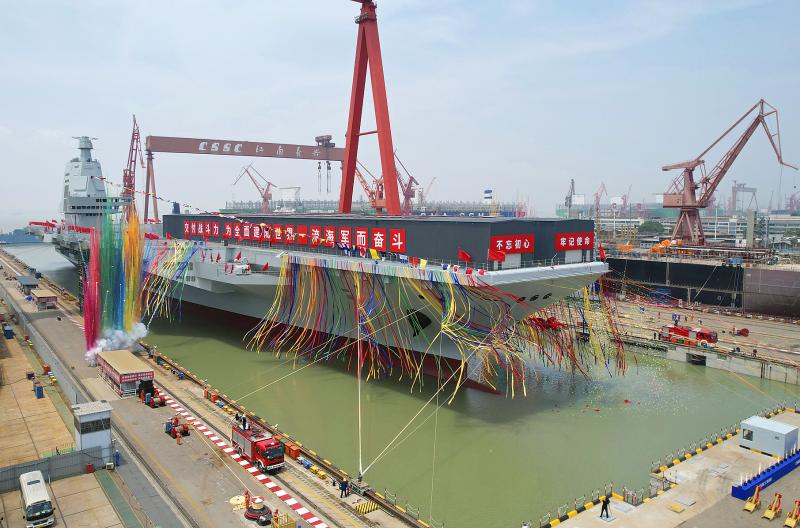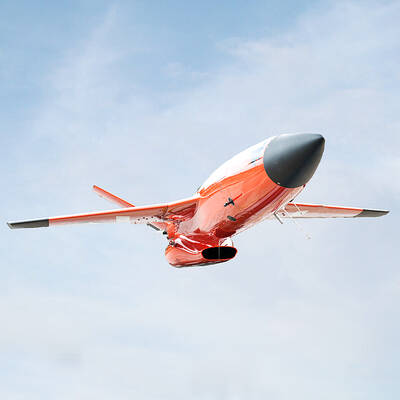Beijing yesterday launched a new-generation aircraft carrier, the first such ship to be designed and built in China, in a milestone as it seeks to extend the range and power of its navy.
The Type 003 carrier christened Fujian left its dry dock at a shipyard outside Shanghai in the morning and tied up at a nearby pier, state media reported.
China Central Television showed assembled navy personnel standing beneath the massive ship as water jets sprayed over its deck, multicolored streamers flew and colored smoke was released.

Photo: AP
Equipped with the latest weaponry and aircraft-launch technology, the ship’s capabilities are thought to rival those of Western carriers, as Beijing seeks to turn its navy, already the world’s largest, into a multi-carrier force.
Satellite imagery captured by Planet Labs PBC on Thursday and analyzed by The Associated Press showed the carrier in what appeared to be a fully flooded dry dock at the Jiangnan Shipyard, near Shanghai, ready for launch. It was draped with red bunting, presumably in preparation for the launch ceremony.
“This is an important milestone for China’s military-industrial complex,” said Ridzwan Rahmat, an analyst with defense intelligence company Janes in Singapore. “This shows that Chinese engineers are now able to indigenously manufacture the full suite of surface combatants associated with modern naval warfare, including corvettes, frigates, destroyers, amphibious assault ships and now an aircraft carrier.”
“This ability to construct a very complex warship from the ground up will inevitably result in various spin-offs and benefits for the Chinese shipbuilding industry,” Rahmat said.
China’s first carrier was a repurposed Soviet ship, and its second was built in China, but based upon a Soviet design. Both were built to employ a so-called “ski-jump” launch method for aircraft, with a ramp at the end of the short runway to help planes take off.
The Type 003 employs a catapult launch, which experts have said appears to be an electromagnetic system, similar to that originally developed by the US Navy.
Xinhua news agency confirmed that the Fujian employed the electromagnetic system in a report on Friday’s launch.
Such a system puts less stress on the aircraft than older steam-type catapult launch systems, and the use of a catapult means that the ship would be able to launch a broader variety of aircraft, which is necessary for China to be able to project naval power at a greater range, Rahmat said.
“These catapults allow aircraft deployed to carry a more extensive load of weapons in addition to external fuel tanks,” Rahmat said.

‘WIN-WIN’: The Philippines, and central and eastern European countries are important potential drone cooperation partners, Minister of Foreign Affairs Lin Chia-lung said Minister of Foreign Affairs Lin Chia-lung (林佳龍) in an interview published yesterday confirmed that there are joint ventures between Taiwan and Poland in the drone industry. Lin made the remark in an exclusive interview with the Chinese-language Liberty Times (the Taipei Times’ sister paper). The government-backed Taiwan Excellence Drone International Business Opportunities Alliance and the Polish Chamber of Unmanned Systems on Wednesday last week signed a memorandum of understanding in Poland to develop a “non-China” supply chain for drones and work together on key technologies. Asked if Taiwan prioritized Poland among central and eastern European countries in drone collaboration, Lin

The Chien Feng IV (勁蜂, Mighty Hornet) loitering munition is on track to enter flight tests next month in connection with potential adoption by Taiwanese and US armed forces, a government source said yesterday. The kamikaze drone, which boasts a range of 1,000km, debuted at the Taipei Aerospace and Defense Technology Exhibition in September, the official said on condition of anonymity. The Chungshan Institute of Science and Technology and US-based Kratos Defense jointly developed the platform by leveraging the engine and airframe of the latter’s MQM-178 Firejet target drone, they said. The uncrewed aerial vehicle is designed to utilize an artificial intelligence computer

The US government has signed defense cooperation agreements with Japan and the Philippines to boost the deterrence capabilities of countries in the first island chain, a report by the National Security Bureau (NSB) showed. The main countries on the first island chain include the two nations and Taiwan. The bureau is to present the report at a meeting of the legislature’s Foreign Affairs and National Defense Committee tomorrow. The US military has deployed Typhon missile systems to Japan’s Yamaguchi Prefecture and Zambales province in the Philippines during their joint military exercises. It has also installed NMESIS anti-ship systems in Japan’s Okinawa

Renewed border fighting between Thailand and Cambodia showed no signs of abating yesterday, leaving hundreds of thousands of displaced people in both countries living in strained conditions as more flooded into temporary shelters. Reporters on the Thai side of the border heard sounds of outgoing, indirect fire yesterday. About 400,000 people have been evacuated from affected areas in Thailand and about 700 schools closed while fighting was ongoing in four border provinces, said Thai Rear Admiral Surasant Kongsiri, a spokesman for the military. Cambodia evacuated more than 127,000 villagers and closed hundreds of schools, the Thai Ministry of Defense said. Thailand’s military announced that